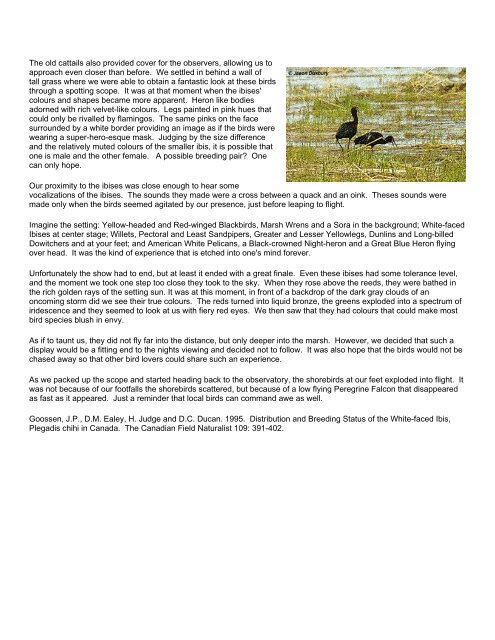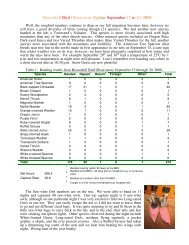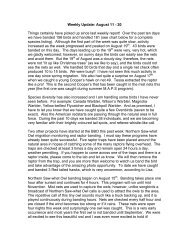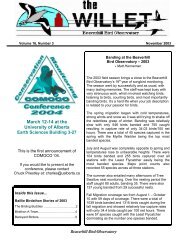The Luck of the Ibis A new species record for Beaverhill Lake
The Luck of the Ibis A new species record for Beaverhill Lake
The Luck of the Ibis A new species record for Beaverhill Lake
Create successful ePaper yourself
Turn your PDF publications into a flip-book with our unique Google optimized e-Paper software.
<strong>The</strong> old cattails also provided cover <strong>for</strong> <strong>the</strong> observers, allowing us toapproach even closer than be<strong>for</strong>e. We settled in behind a wall <strong>of</strong>tall grass where we were able to obtain a fantastic look at <strong>the</strong>se birdsthrough a spotting scope. It was at that moment when <strong>the</strong> ibises'colours and shapes became more apparent. Heron like bodiesadorned with rich velvet-like colours. Legs painted in pink hues thatcould only be rivalled by flamingos. <strong>The</strong> same pinks on <strong>the</strong> facesurrounded by a white border providing an image as if <strong>the</strong> birds werewearing a super-hero-esque mask. Judging by <strong>the</strong> size differenceand <strong>the</strong> relatively muted colours <strong>of</strong> <strong>the</strong> smaller ibis, it is possible thatone is male and <strong>the</strong> o<strong>the</strong>r female. A possible breeding pair? Onecan only hope.Our proximity to <strong>the</strong> ibises was close enough to hear somevocalizations <strong>of</strong> <strong>the</strong> ibises. <strong>The</strong> sounds <strong>the</strong>y made were a cross between a quack and an oink. <strong>The</strong>ses sounds weremade only when <strong>the</strong> birds seemed agitated by our presence, just be<strong>for</strong>e leaping to flight.Imagine <strong>the</strong> setting: Yellow-headed and Red-winged Blackbirds, Marsh Wrens and a Sora in <strong>the</strong> background; White-faced<strong>Ibis</strong>es at center stage; Willets, Pectoral and Least Sandpipers, Greater and Lesser Yellowlegs, Dunlins and Long-billedDowitchers and at your feet; and American White Pelicans, a Black-crowned Night-heron and a Great Blue Heron flyingover head. It was <strong>the</strong> kind <strong>of</strong> experience that is etched into one's mind <strong>for</strong>ever.Un<strong>for</strong>tunately <strong>the</strong> show had to end, but at least it ended with a great finale. Even <strong>the</strong>se ibises had some tolerance level,and <strong>the</strong> moment we took one step too close <strong>the</strong>y took to <strong>the</strong> sky. When <strong>the</strong>y rose above <strong>the</strong> reeds, <strong>the</strong>y were ba<strong>the</strong>d in<strong>the</strong> rich golden rays <strong>of</strong> <strong>the</strong> setting sun. It was at this moment, in front <strong>of</strong> a backdrop <strong>of</strong> <strong>the</strong> dark gray clouds <strong>of</strong> anoncoming storm did we see <strong>the</strong>ir true colours. <strong>The</strong> reds turned into liquid bronze, <strong>the</strong> greens exploded into a spectrum <strong>of</strong>iridescence and <strong>the</strong>y seemed to look at us with fiery red eyes. We <strong>the</strong>n saw that <strong>the</strong>y had colours that could make mostbird <strong>species</strong> blush in envy.As if to taunt us, <strong>the</strong>y did not fly far into <strong>the</strong> distance, but only deeper into <strong>the</strong> marsh. However, we decided that such adisplay would be a fitting end to <strong>the</strong> nights viewing and decided not to follow. It was also hope that <strong>the</strong> birds would not bechased away so that o<strong>the</strong>r bird lovers could share such an experience.As we packed up <strong>the</strong> scope and started heading back to <strong>the</strong> observatory, <strong>the</strong> shorebirds at our feet exploded into flight. Itwas not because <strong>of</strong> our footfalls <strong>the</strong> shorebirds scattered, but because <strong>of</strong> a low flying Peregrine Falcon that disappearedas fast as it appeared. Just a reminder that local birds can command awe as well.Goossen, J.P., D.M. Ealey, H. Judge and D.C. Ducan. 1995. Distribution and Breeding Status <strong>of</strong> <strong>the</strong> White-faced <strong>Ibis</strong>,Plegadis chihi in Canada. <strong>The</strong> Canadian Field Naturalist 109: 391-402.









